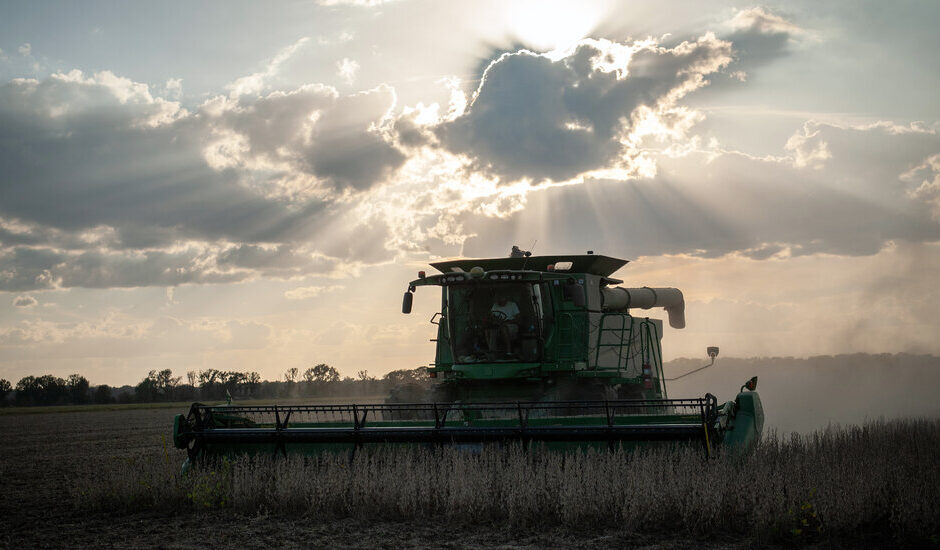Follow the latest news on Trump’s tariffs and administration news.
Ahead of President Trump’s plan to impose sweeping tariffs across the globe this week, his administration is weighing a new round of emergency aid to farmers, who are likely to be caught in the middle if America’s trading partners retaliate.
The early discussions offer a tacit acknowledgment that Mr. Trump’s expansive tariffs could unleash financial devastation throughout the U.S. agricultural industry, a crucial voting base that the president similarly tried to safeguard during his 2018 trade war with China.
While the president has not announced any details of an aid package, his advisers have signaled in recent days that he could follow a playbook similar to the one he used in his first term, when he directed billions in payments to farmers who saw their exports to China plummet amid a trade war with Beijing.
Such a rescue package ultimately proved expensive, with the government shelling out about $23 billion after China imposed high retaliatory duties on soybean, corn, wheat and other American imports beginning in 2018. That money came from a fund at the U.S. Department of Agriculture, a portion of which can be used to respond to emergencies, including trade disputes.
Brooke Rollins, the agriculture secretary, said last week that the administration may look to offer emergency aid to farmers, telling reporters that Mr. Trump had asked her to “have some programs in place that would potentially mitigate any economic catastrophes that could happen” in a global trade standoff.
But the price tag this time could prove even higher, since Mr. Trump has threatened to target many countries, including American allies like Europe, Canada, Mexico and Japan. The potential scope of their collective retribution could inflict deeper, more lasting harm on American businesses.
“That could really lead to big demands in terms of trying to help farmers,” said Joseph Glauber, a research fellow at the International Food Policy Research Institute who previously served as the chief economist for U.S.D.A.
Administration officials have discussed the early contours of a possible farmer bailout with industry lobbying groups and Republican congressional offices, according to four people familiar with the matter, who spoke on condition of anonymity to describe the talks. They have raised a few potential mechanisms for providing the funds, some of which may require legislation, the people said, cautioning that the conversations were in early stages because Mr. Trump has not yet finalized his trade strategy.
But an expensive federal bailout threatens to cut deeply into one of Mr. Trump’s signature reasons for pursuing protectionist policies in the first place: a desire to rake in “lots of money,” as the president himself has said. Mr. Trump and his Republican allies say the new tariffs could help pay for their still-forming plan to expand and extend a set of expiring tax cuts, which could cost into the trillions of dollars.
“In addition to consumers being impacted by tariffs, now you have taxpayers who are going to be on the hook,” said Alex Durante, a senior economist at the Tax Foundation, a think tank that generally favors lower taxes.
The White House declined to comment, but an official — speaking only on condition of anonymity — said any discussions about tariff aid are preliminary given the ongoing discussions about Mr. Trump’s tariffs and his negotiations with other countries.
The U.S.D.A. did not respond to a request for comment.
While Mr. Trump has signaled in recent days he might relax his original, aggressive ambitions, he has forged ahead with a plan to impose “retaliatory” tariffs on nations that impose duties or erect other costly trade barriers to U.S. imports. The president has promised the tariffs starting April 2 would be significant, as he looks to raise revenue, reset the nation’s trade relationships and cajole firms into manufacturing more of their products in the United States.
“We may take less than what they’re charging. Because they’ve charged us so much, I don’t think they could take it,” Mr. Trump said on Monday.
Economists broadly warn that the tariffs could fall heavily on American consumers, particularly if firms raise prices to compensate for the fact that they must pay more to import necessary goods. Those anxieties helped to send consumer confidence tumbling this month to its lowest level since January 2021, according to findings released Tuesday from the Conference Board.
But the impact on farmers is expected to be particularly acute. China, which has been hit with 20 percent tariffs since Mr. Trump took office, has already retaliated with levies on chicken, wheat, corn and cotton. The European Union has drawn up a sizable list of agricultural and consumer products to target if Mr. Trump makes good on his threat to impose steep tariffs on that bloc.
Many domestic producers worry that Mr. Trump’s tariffs could undercut commodity prices and make their corn, eggs, soybeans and other goods less desirable to foreign purchasers if those nations respond with levies on American exports.
“Obviously, we’re concerned with the economics of where we’re at today,” said Kenneth Hartman Jr., an Illinois farmer who serves as the president of the Corn Board of the National Corn Growers Association.
Once Mr. Trump’s tariffs take effect, Mr. Hartman said his industry would “love to see some new markets come about.” But he also expressed concern about a prolonged trade war, which could result in U.S. growers ceding markets to foreign competitors — or, worse yet, facing the risk of harsh retaliation from its longtime trade partners, particularly Mexico.
“That’s probably our biggest concern right now,” Mr. Hartman said.
Retaliation for Mr. Trump’s last tariff campaign, starting in 2018, resulted in a $27 billion loss in agricultural exports over that period, according to estimates by U.S.D.A. economists. Much of the losses came as a result of a trade war with China, after Mr. Trump targeted a vast swath of the country’s exports, prompting Beijing to mete out its own punishment.
One idea the administration has weighed is whether to offer new tariff relief through the Commodity Credit Corporation at U.S.D.A., according to the people familiar with the matter.
The Commodity Credit Corporation is a key U.S.D.A funding vehicle: It supplies the money for federal programs to support farm incomes, stabilize commodity prices and respond to natural disasters. While its finances are complicated, the entity may borrow up to $30 billion from the Treasury Department.
In Mr. Trump’s first term, the U.S.D.A. program doled out money based on a formula that projected agricultural losses. The funding salved some of the sting from the trade war — and offered a political boon to Mr. Trump entering an election year — but it also faced significant complaints from farmers that the aid was slow and hard to access.
Josh Gackle, the chairman of the American Soybean Association, said the industry’s preference is not for government handouts but “access to a free and fair trade market.” In the meantime, he said he hoped the administration could “find a way to address that financial impact on our farms” from the upcoming tariffs.
But there are growing doubts as to whether U.S.D.A has the funding at its disposal to assist farmers, especially if Mr. Trump’s upcoming tariffs cause widespread international blowback.
Any gap might require Congress to replenish the agency’s borrowing authority early, raising a complicated political debate on Capitol Hill, where some conservative Republicans historically have criticized the U.S.D.A. program and sought to restrict the way that the department can spend its funds.
#Trump #Tariffs #Loom #White #House #Eyes #Costly #Farmer #Bailouts


